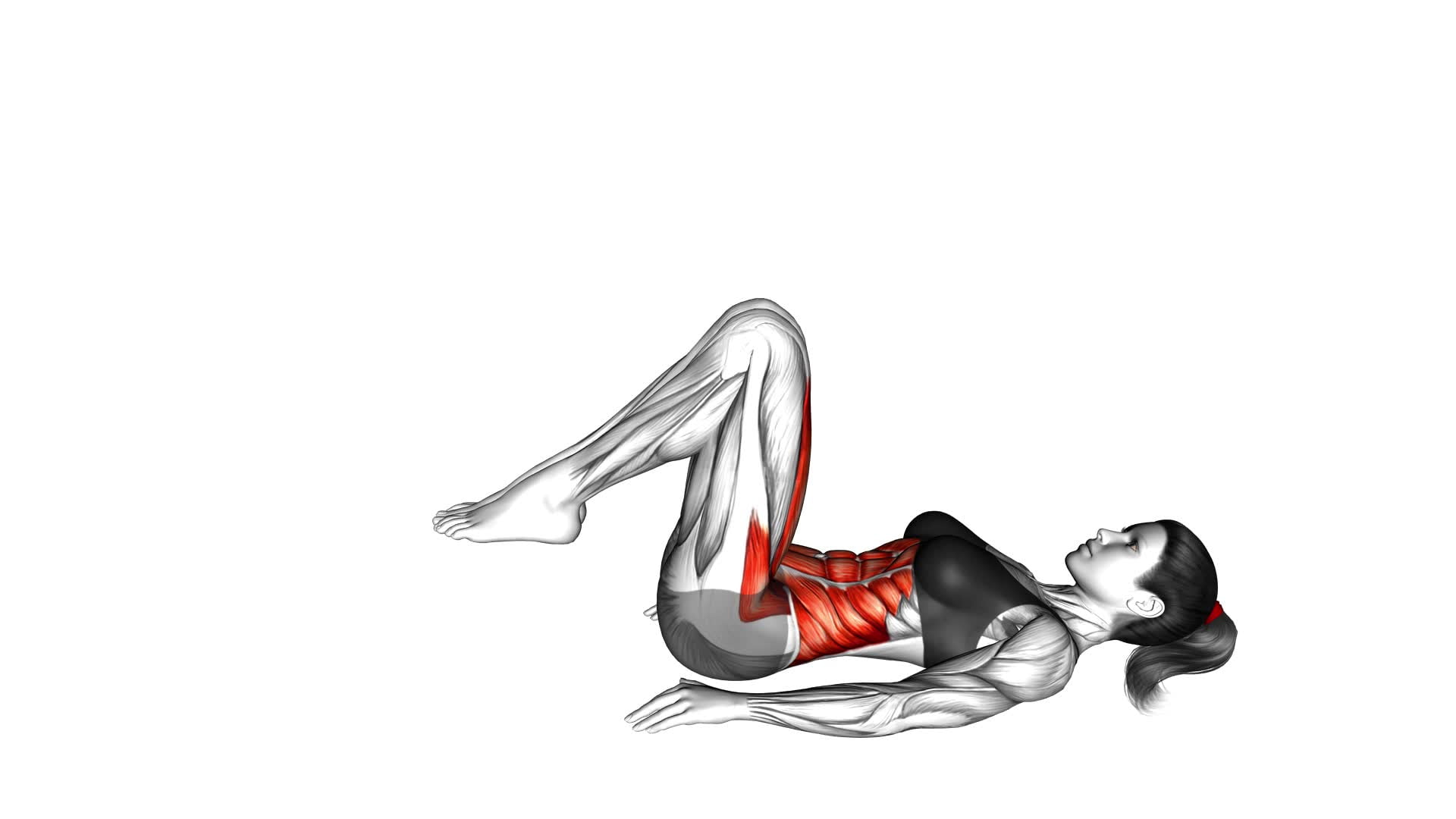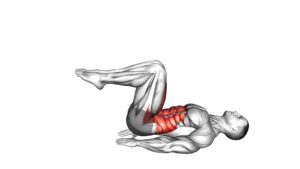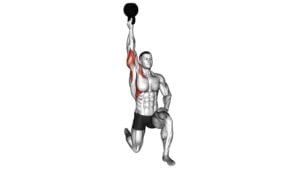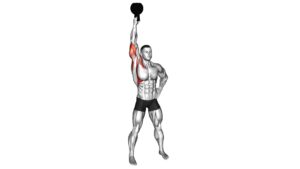Bottoms-Up (female) – Video Exercise Guide & Tips

Get ready to take your fitness to the next level with Bottoms-Up exercises! In this video exercise guide, you'll discover the benefits, essential equipment, and proper form for maximum results.
Watch This Exercise Video
Whether you're a beginner looking to start your fitness journey or an advanced athlete seeking a challenge, we've got you covered. Plus, we'll share tips on how to progress safely and avoid injury.
Let's dive in and sculpt those bottoms with confidence!
Key Takeaways
- Bottoms-up exercises improve core stability and engage core muscles.
- They target different muscle groups, including the abdominal muscles, lower back, and hips.
- Bottoms-up exercises enhance overall stability, posture, and fitness level.
- It is important to use proper form and technique to maximize results and avoid common mistakes.
Benefits of Bottoms-Up Exercises
Discover the numerous benefits you can experience from incorporating bottoms-up exercises into your workout routine.
Bottoms-up exercises offer a range of advantages that can enhance your overall fitness and strength.
One of the main benefits is improved core stability. By performing exercises like bottoms-up kettlebell presses or bottoms-up carries, you engage your core muscles to maintain balance and control. This not only strengthens your core but also improves your overall stability and posture.
Another benefit of bottoms-up exercises is increased grip strength. When you hold the weight upside down, as in bottoms-up exercises, it requires a greater amount of grip strength to keep the weight stable. Regularly incorporating bottoms-up exercises into your routine can help strengthen your grip, which can be beneficial for various activities, such as lifting heavy objects or participating in sports that require a strong grip.
Additionally, bottoms-up exercises provide variations that can target different muscle groups. For example, bottoms-up squats can engage your lower body muscles, while bottoms-up rows can target your back and arm muscles. By incorporating these variations into your routine, you can work different muscle groups and achieve a well-rounded workout.
Incorporating bottoms-up exercises into your workout routine can offer a range of benefits, including improved core stability, increased grip strength, and targeted muscle engagement through various exercise variations. Consider adding these exercises to your fitness regimen to enhance your overall strength and fitness levels.
Essential Equipment for Bottoms-Up Workouts
To maximize your Bottoms-Up workouts, there are a few essential pieces of equipment you'll need.
First, make sure you have a set of dumbbells or kettlebells that are suitable for your fitness level. Beginners can start with lighter weights and gradually increase as they get stronger.
For those looking for a challenge, advanced tools like resistance bands or stability balls can be incorporated to intensify the workout.
Must-Have Gear for Bottoms-Up Workouts
Make sure you have the essential gear for bottoms-up workouts to maximize your results. When it comes to workout attire, opt for comfortable and breathable clothing that allows for freedom of movement. Choose moisture-wicking fabrics to keep you dry and comfortable throughout your workout.
As for footwear, it's important to wear shoes that provide adequate support and stability. Look for trainers or sneakers with good arch support and cushioning to protect your feet and joints. Avoid wearing sandals or flip flops as they don't provide the necessary support for the dynamic movements involved in bottoms-up workouts.
Investing in proper workout attire and recommended footwear will help you perform at your best and minimize the risk of injury.
Equipment Options for Beginners
To get started with bottoms-up workouts as a beginner, you'll need a few essential pieces of equipment. Luckily, there are beginner-friendly workout routines that offer alternatives to traditional exercise equipment.
One option is resistance bands, which come in different levels of resistance and can be used for a variety of exercises, including bottoms-up movements. They're lightweight, portable, and great for targeting specific muscle groups.
Another alternative is using your own body weight. Exercises like squats, lunges, and glute bridges can be done without any equipment and still provide a challenging workout for your lower body.
Additionally, you may consider using stability balls or yoga blocks to enhance your workout and add variation to your routine.
Advanced Tools for Challenging Workouts
For an even more challenging bottoms-up workout, you can take advantage of advanced tools that are essential equipment for targeting specific muscle groups. These tools provide added resistance and intensity to your workouts, helping you to push your limits and achieve greater results.
Some examples of advanced tools that you can incorporate into your challenging workouts include resistance bands, kettlebells, and weighted vests. Resistance bands can be used to add resistance to exercises such as squats and lunges, targeting your glutes and legs.
Kettlebells are great for challenging your core and upper body strength, with exercises like kettlebell swings and Turkish get-ups.
Weighted vests can be worn during bodyweight exercises, increasing the resistance and making your workouts more challenging.
Incorporating these advanced tools into your workouts will help you take your bottoms-up exercises to the next level and achieve your fitness goals.
Proper Form and Technique for Maximum Results
To maximize your results during Bottoms-Up workouts, it's crucial to maintain correct posture throughout each exercise. By keeping your spine aligned and engaging your core muscles, you won't only target the desired muscles more effectively but also reduce the risk of injury.
Additionally, be mindful of common mistakes such as rounding your back or using momentum to complete the movements, as these can diminish the effectiveness of the workout.
Correct Posture Importance
Maintain proper form and technique to maximize your results by focusing on the correct posture during the Bottoms-Up (female) exercise.
Correct posture is crucial for injury prevention and ensuring that you're effectively targeting the muscles involved in this exercise.
To achieve the correct posture, stand with your feet shoulder-width apart, engage your core, and keep your back straight. Avoid arching your back or rounding your shoulders, as this can put unnecessary strain on your spine and lead to injury.
Additionally, keep your head aligned with your spine and avoid tilting it forward or backward.
Avoiding Common Mistakes
Make sure you avoid these common mistakes to maintain proper form and technique and achieve maximum results during the Bottoms-Up (female) exercise.
- Improper alignment: One of the most common pitfalls isn't maintaining proper alignment throughout the exercise. Make sure your feet are hip-width apart, knees slightly bent, and your core engaged. Avoid arching your back or rounding your shoulders.
- Lack of stability: Another mistake to avoid isn't having enough stability during the exercise. Make sure you have a stable surface to perform the exercise on and use a mat to prevent slipping. Additionally, engage your glutes and core to maintain stability throughout the movement.
- Overworking the arms: Many people make the mistake of relying solely on their arms to lift their body during the exercise. Remember to engage your glutes and legs as well to distribute the workload evenly and avoid putting excessive strain on your arms.
Beginner-Friendly Bottoms-Up Exercises
You can gradually incorporate beginner-friendly bottoms-up exercises into your workout routine to gradually build strength and improve your overall fitness level. These exercises offer numerous benefits for your body and can be done with proper form and technique.
One of the main benefits of bottoms-up exercises is that they engage your core muscles. When you hold the weight upside down, your core muscles have to work harder to stabilize your body. This helps to strengthen your abdominal muscles, lower back, and hips.
Proper form and technique are crucial when performing bottoms-up exercises. Start with a lighter weight and focus on maintaining control throughout the movement. Keep your core engaged, your shoulders down and back, and your spine neutral. Avoid using momentum to lift the weight, as this can lead to injury.
Some beginner-friendly bottoms-up exercises you can try include bottoms-up kettlebell presses, bottoms-up kettlebell squats, and bottoms-up kettlebell deadlifts. These exercises target multiple muscle groups and can help improve your overall strength and stability.
Incorporating beginner-friendly bottoms-up exercises into your workout routine can be a great way to challenge your muscles and take your fitness to the next level. Just remember to start slow, focus on proper form, and listen to your body to avoid injury.
Advanced Bottoms-Up Exercises for a Challenge
To further challenge yourself and enhance your fitness routine, delve into the realm of advanced bottoms-up exercises. These variations won't only target your lower body muscles but also engage your core and increase your overall strength. Here are three advanced bottoms-up exercises that you can incorporate into your routine:
- Bottoms-Up Pistol Squats: Begin by holding a kettlebell upside down by the handle with one hand. Keep your arm extended and perform a pistol squat, lowering your body down while keeping your balance. This exercise not only strengthens your legs but also improves stability and coordination.
- Bottoms-Up Bulgarian Split Squats: Place one foot on a bench or elevated surface behind you, while holding a kettlebell upside down with the same-side hand. Lower your body down into a split squat position, keeping your torso upright. This exercise targets your glutes, quads, and hamstrings, while also challenging your balance.
- Bottoms-Up Single-Leg Deadlifts: Hold a kettlebell upside down by the handle with one hand. Standing on one leg, hinge forward at the hips while extending your other leg behind you. Keep your back straight and lower the kettlebell towards the ground, then return to the starting position. This exercise strengthens your hamstrings, glutes, and improves stability in your core.
Incorporating these advanced bottoms-up variations into your routine will take your fitness to the next level, providing new challenges and helping you achieve your fitness goals.
Tips for Safely Progressing and Avoiding Injury
Safely progressing and avoiding injury while incorporating advanced bottoms-up exercises can be achieved by following these tips.
First and foremost, it's crucial to prioritize safety precautions throughout your workouts. Make sure to warm up properly before starting any intense exercise routine. This will help prepare your muscles and joints for the challenging movements ahead. Additionally, always listen to your body and pay attention to any signs of discomfort or pain. If something doesn't feel right, modify the exercise or take a break to prevent potential injury.
Another important aspect of injury prevention is maintaining proper form and technique. When performing bottoms-up exercises, focus on engaging the correct muscles and maintaining stability. It can be helpful to work with a qualified trainer or watch instructional videos to ensure you're executing the exercises correctly.
As you progress in your training, gradually increase the intensity and difficulty of the exercises. However, it's essential to do so in a controlled manner. Avoid rushing into advanced movements before you're ready, as this can increase the risk of injury. Take your time and gradually build up your strength and stability.
Lastly, always prioritize rest and recovery. Allow your body enough time to recover between workouts to avoid overuse injuries. Incorporate rest days into your training schedule and listen to your body's needs.
Frequently Asked Questions
How Long Should I Rest Between Sets When Performing Bottoms-Up Exercises?
When performing bottoms-up exercises, it's important to consider the rest duration between sets. Resting for about 30-60 seconds between sets allows your muscles to recover and regain energy for the next set. This rest period is crucial for maintaining proper form and preventing muscle fatigue.
Bottoms-up exercises have several benefits, including improving core stability, grip strength, and shoulder stability. Incorporating adequate rest into your workout routine will optimize the effectiveness of these exercises.
Can Bottoms-Up Exercises Help Improve My Balance and Stability?
Bottoms-up exercises can be a great way to improve your balance and stability. By incorporating these exercises into your workout routine, you can work on improving your coordination and increasing your core strength.
These exercises challenge your body to maintain proper alignment and control, which can translate into better balance and stability in everyday activities.
Are Bottoms-Up Exercises Suitable for Individuals With Lower Back Pain?
Bottoms-up exercises can be beneficial for improving balance and stability. However, if you have lower back pain, it's important to modify these exercises to avoid further discomfort.
Instead of traditional bottoms-up exercises, you can try alternative exercises that are gentler on the lower back. Consult with a qualified fitness professional who can provide you with modifications and recommend suitable exercises that will help you improve your stability without exacerbating your lower back pain.
What Are Some Common Mistakes to Avoid When Performing Bottoms-Up Exercises?
When performing bottoms-up exercises, it's important to be aware of common mistakes to avoid and focus on maintaining proper form. By understanding these mistakes, you can ensure that you're getting the most out of your workout while minimizing the risk of injury.
Whether it's using too much weight, not engaging your core, or rushing through the movement, being mindful of these errors will help you achieve better results and prevent any setbacks in your fitness journey.
Can Bottoms-Up Exercises Be Incorporated Into a Full-Body Workout Routine?
Yes, bottoms-up exercises can definitely be incorporated into a full-body workout routine.
By incorporating bottoms-up exercises into a HIIT routine, you can reap the benefits of improved core strength.
These exercises challenge your stability and engage your entire body, making them a great addition to any workout.
Conclusion
In conclusion, bottoms-up exercises are a great way to strengthen and tone your lower body muscles.
By using the proper equipment and maintaining proper form and technique, you can maximize your results and avoid injury.
Whether you're a beginner or advanced, there are a variety of exercises available to challenge and progress your fitness level.
Remember to always prioritize safety and listen to your body as you work towards achieving your fitness goals.

Author
Years ago, the spark of my life’s passion ignited in my mind the moment I stepped into the local gym for the first time. The inaugural bead of perspiration, the initial endeavor, the very first surge of endorphins, and a sense of pride that washed over me post-workout marked the beginning of my deep-seated interest in strength sports, fitness, and sports nutrition. This very curiosity blossomed rapidly into a profound fascination, propelling me to earn a Master’s degree in Physical Education from the Academy of Physical Education in Krakow, followed by a Sports Manager diploma from the Jagiellonian University. My journey of growth led me to gain more specialized qualifications, such as being a certified personal trainer with a focus on sports dietetics, a lifeguard, and an instructor for wellness and corrective gymnastics. Theoretical knowledge paired seamlessly with practical experience, reinforcing my belief that the transformation of individuals under my guidance was also a reflection of my personal growth. This belief holds true even today. Each day, I strive to push the boundaries and explore new realms. These realms gently elevate me to greater heights. The unique combination of passion for my field and the continuous quest for growth fuels my drive to break new ground.







